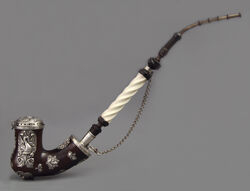
My focus is the multiple iterations of the pipe within the wider Atlantic basin arising from Indigenous forms, media that came to define this period, its solitary reveries and diverse sociabilities, systems of power, and deft resistances. Its look and shape, feel and function footnote the transformational features of the early modern Atlantic world: landscapes of exchange. 5 The tobacco pipe was a powerful translational tool. Directing particular attention to the myriad of “subaltern technologies” that distinguished these works, systems of knowing and doing that ultimately revised wider material worlds, Norton delivers a riposte to the historic denial of “imperial and colonial dependence” on these technologies.

4 Norton argues for the term “technology” as a means to encapsulate tangible media-including tobacco pipes -which also includes the wisdom, cultural, and spiritual facets of things arising from the Indigenous Americas.

These materialities spread through colonial and metropolitan polities and cultures. 3 These histories reveal the porosity of European and Euro-colonial societies and the dependence of elite Europeans on material cultures that can be incorporated into the term Indigenous technology (whether arts, material culture, or processes of use). Marcy Norton is prominent among the new generation of historians who place Indigenous American and African peoples at the center of early modern Atlantic world events. Studies, such as this one, open vital historical vantage points, where subaltern knowledge and agency figure in singular ways. 2 Understanding these changes is better achieved through investigations outside privileged realms, including with media like tobacco and the material meanings that ensued with its travels. The concept of early modernity is shaking off its old Eurocentric connotations as historians of other regions and peoples find “common threads in the worldwide experience” of these centuries, most specifically in the “worldwide diffusion of new commodities.” 1 This era is notable for more intensive and sustained interactions, including the translation of highly esteemed goods arising from Indigenous North American, African, Arabian and Asian cultures, moving to far flung world centers through the entanglement of people, goods, and political circumstance.


 0 kommentar(er)
0 kommentar(er)
